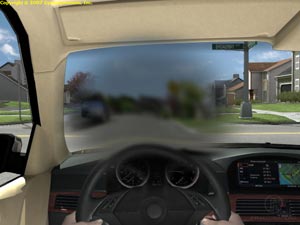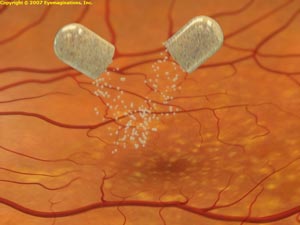 What is age-related macular degeneration (AMD)?
What is age-related macular degeneration (AMD)?
AMD is a common eye disease associated with aging that gradually destroys sharp, central vision. Central vision is needed for seeing objects clearly and for common daily tasks such as reading and driving. In some people, AMD advances so slowly that it will have little effect on their vision as they age. But in others, the disease progresses faster and may lead to a loss of vision in one or both eyes.
How does AMD damage vision?
The retina is a paper-thin tissue that lines the back of the eye and sends visual signals to the brain. In the middle of the retina is a tiny area called the macula. The macula is made up of millions of light-sensing cells that help to produce central vision.
AMD occurs in two forms:
- Dry AMD
Ninety percent of all people with AMD have this type. Scientists are still not sure what causes dry AMD. Studies suggest that an area of the retina becomes diseased, leading to the slow breakdown of the light-sensing cells in the macula and a gradual loss of central vision.
- Wet AMD
Although only 10 percent of all people with AMD have this type, it accounts for 90 percent of all blindness from the disease. As dry AMD worsens, new blood vessels may begin to grow and cause “wet” AMD. Because these new blood vessels tend to be very fragile, they will often leak blood and fluid under the macula. This causes rapid damage to the macula that can lead to the loss of central vision in a short period of time.
Who is most likely to get AMD?
The greatest risk factor is age. Although AMD may occur during middle age, studies show that people over age 60 are clearly at greater risk than other age groups. For instance, a large study found that people in middle-age have about a 2 percent risk of getting AMD, but this risk increased to nearly 30 percent in those over age 75.
Other AMD risk factors include:
- Gender
Women tend to be at greater risk for AMD than men.
- Race
Whites are much more likely to lose vision from AMD than Blacks.
- Smoking
Smoking may increase the risk of AMD.
- Family History
Those with immediate family members who have AMD are at a higher risk of developing the disease.
What are the symptoms?
Both dry and wet AMD cause no pain. The most common early sign of dry AMD is blurred vision. As fewer cells in the macula are able to function, people will see details less clearly in front of them, such as faces or words in a book. Often this blurred vision will go away in brighter light. If the loss of these light-sensing cells becomes great, people may see a small, but growing,blind spot in the middle of their field of vision.
The classic early symptom of wet AMD is that straight lines appear crooked. This results when fluid from the leaking blood vessels gathers and lifts the macula, distorting vision. A small blind spot may also appear in wet AMD, resulting in loss of one’s central vision.
How is it detected?
Your eye care professional may suspect AMD if you are over age 60 and have had recent changes in your central vision. To look for signs of the disease, he or she will use eye drops to dilate, or enlarge, your pupils. Dilating the pupils allows your eye care professional to view the back of the eye better.
Normal Macula vs. Macula with AMD
You may also be asked to view an Amsler grid, a pattern that looks like a checkerboard. Early changes in your central vision will cause the grid to appear distorted, a sign of AMD.
No treatment now exists for dry AMD. It has been suggested that taking certain extra vitamins and minerals may slow the progress of the disease. But this treatment needs much more research before scientists can know for sure if it’s helpful.
Eye care professionals can treat some cases of wet AMD with laser surgery. This treatment involves aiming a strong light beam onto the new blood vessels to destroy them. Laser surgery is done in a doctor’s office or in an eye clinic and lasts a short period of time. Although a person may go home the same day, he or she will need to return for follow-up exams.
What research is being done?
The National Eye Institute is funding a number of research studies to learn what causes AMD and how it can be better treated. For instance, in the Age-Related Eye Diseases Study (AREDS), researchers are assessing the aging process in the eyes of thousands of older people to discover the earliest signs of AMD. The same study is also evaluating the effects of certain vitamins and minerals in preventing or slowing the progress of AMD.
At the same time, other scientists are trying to learn more about how the cells in the retina work. This knowledge will allow them some day to pinpoint the cause of the disease and design methods to prevent it.
 What can you do to protect your vision?
What can you do to protect your vision?
Although there is no effective treatment for dry AMD at this time, it is crucial that those who progress to wet AMD and need laser surgery have it before the disease destroys central vision. For this reason, if you have dry AMD or are age 60 or older, you should have your eyes examined through dilated pupils at least once a year. You may also want to get an Amsler grid from your eye care professional to check your vision at home.
To learn more about AMD, write: National Eye Health Education Program, 2020 Vision Place, Bethesda, MD 20892-3655.
Source: National Eye Institute, National Institutes of Health.

